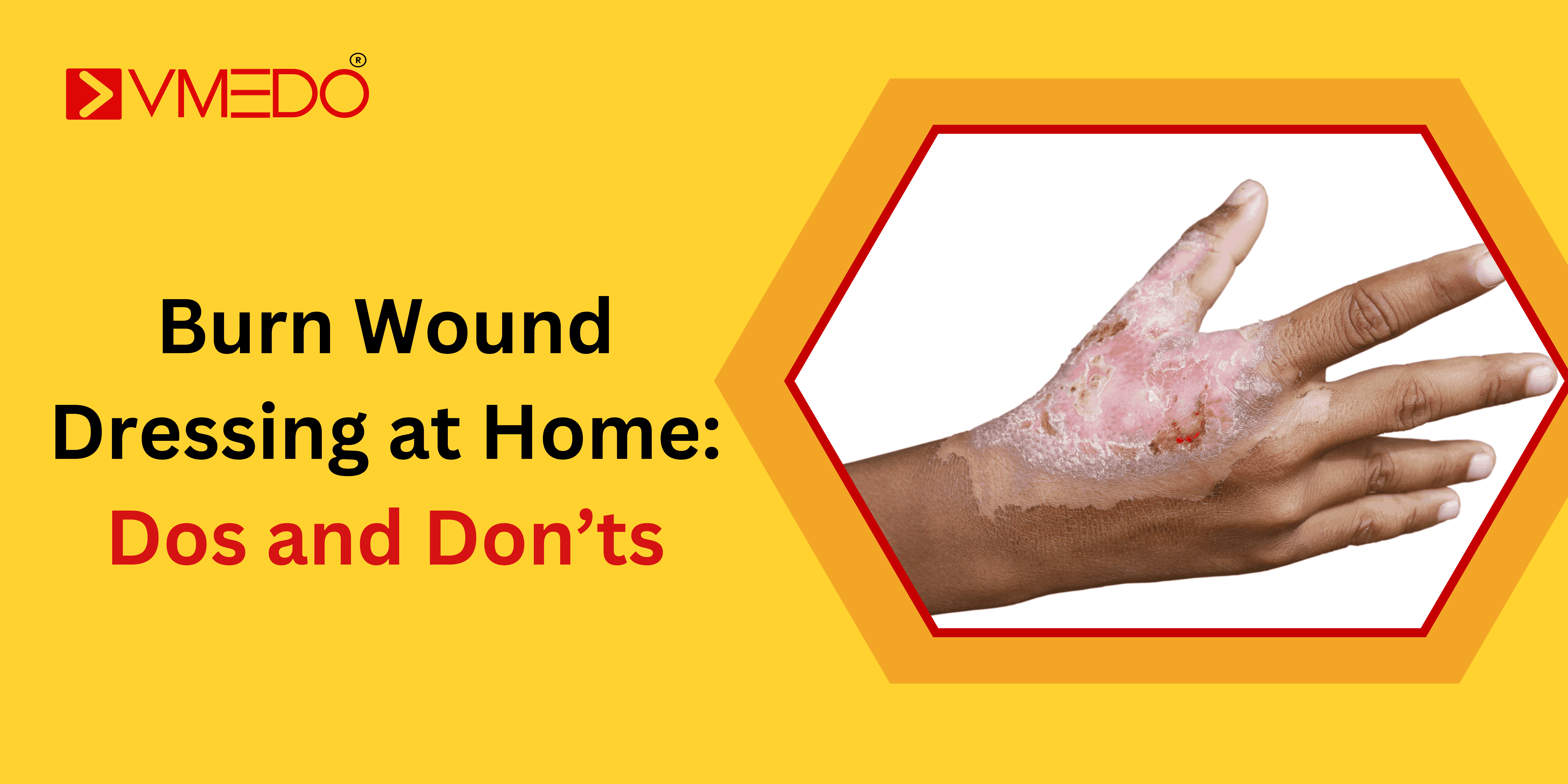Burns are among the most common household injuries. Whether caused by hot liquids, steam, fire, chemicals, or electricity, burns can be painful and distressing. In minor cases, burns can be managed effectively at home with proper wound care. However, incorrect treatment can lead to infections, delayed healing, and complications. This blog by VMEDO, your trusted partner in urgent healthcare services at home, aims to educate you about the Burn Wound Dressing at Home: Dos and Don’ts
Understanding Burn Degrees
Before diving into the care instructions, it’s important to understand the severity of burns, as this determines whether home treatment is appropriate:
First-degree burns (Superficial)
-
Affects only the outer layer of the skin (epidermis)
-
Symptoms: Redness, minor swelling, and pain
-
Example: Mild sunburn or brief contact with hot objects
Second-degree burns (Partial Thickness)
-
Affects the epidermis and part of the dermis (second layer)
-
Symptoms: Blisters, intense redness, swelling, and pain
-
May require professional medical assistance
Third-degree burns (Full Thickness)
-
Affects all layers of skin and possibly underlying tissues
-
Symptoms: White, blackened, or charred skin; may be numb due to nerve damage
-
Requires emergency medical attention – do not attempt home care
Dos of Burn Wound Dressing at Home
1. Cool the Burn Immediately
- Hold the burned area under cool (not ice-cold) running water for 10-15 minutes.
- Alternatively, use a clean, wet cloth to cool the area.
- Why? Cooling reduces pain, swelling, and further tissue damage.
2. Clean the Burn Gently
- Wash the burn with mild soap and water to remove debris.
- Avoid scrubbing, as it can worsen the injury.
- Pat dry with a clean, soft cloth.
3. Apply an Antibiotic Ointment (For Minor Burns)
- Use petroleum jelly or antibiotic creams (like Neosporin) to keep the wound moist.
- Avoid home remedies like butter, toothpaste, or oils, as they can trap heat and cause infection.
4. Use a Sterile Non-Stick Dressing
- Cover the burn with a non-adhesive sterile gauze or bandage.
- Change the dressing once or twice daily, or if it gets wet or dirty.
- Why? A sterile dressing protects against bacteria and prevents friction.
5. Take Pain Relievers if Needed
- Over-the-counter painkillers like ibuprofen or acetaminophen can help with discomfort.
- Avoid aspirin for children, as it may cause complications.
6. Keep the Burn Elevated (If Possible)
- If the burn is on a limb, elevate it to reduce swelling.
7. Watch for Signs of Infection
- Increased pain, redness, swelling, pus, or fever may indicate infection.
- Seek medical help if these symptoms appear.
Don’ts of Burn Wound Dressing at Home
1. Don’t Use Ice or Very Cold Water
- Ice can cause frostbite and further damage the skin.
- Stick to cool (not icy) water.
2. Don’t Pop Blisters
- Blisters act as a natural barrier against infection.
- Popping them increases infection risk and slows healing.
3. Don’t Apply Butter, Oil, or Toothpaste
- These trap heat and can introduce bacteria.
- Stick to medical-grade ointments instead.
4. Don’t Use Cotton Balls or Fluffy Bandages
- Fibers can stick to the burn and cause irritation.
- Use non-stick gauze for dressing.
5. Don’t Peel Off Dead Skin
- Let the skin shed naturally to avoid scarring.
- Forcing peeling can reopen wounds and delay healing.
6. Don’t Ignore Severe Burns
- If the burn is larger than 3 inches, on the face, hands, or genitals, or is a third/fourth-degree burn, seek emergency care immediately.
7. Don’t Use Tight Bandages
- Tight wraps can restrict blood flow and increase swelling.
- Keep the dressing snug but not constricting.
How to Dress a Minor Burn at Home
Dressing a burn wound properly promotes healing and prevents infection. Here’s a step-by-step guide to burn wound dressing at home:
Clean the Wound
DO:
-
Wash hands thoroughly before touching the wound.
-
Gently clean the area using mild soap and cool water.
-
Pat dry with a sterile gauze pad or clean towel.
DON’T:
-
Do not scrub or rub the burn area.
-
Avoid using hydrogen peroxide or alcohol, which can irritate the skin and slow healing.
Apply an Ointment
DO:
-
Apply a thin layer of antibiotic ointment like silver sulfadiazine (if prescribed) or over-the-counter burn creams.
-
You can also use aloe vera gel for its cooling and anti-inflammatory properties.
DON’T:
-
Avoid ointments with fragrance, alcohol, or coloring agents.
-
Do not apply butter, oil, toothpaste, or raw eggs – these are myths and can cause infection.
Cover the Burn
DO:
-
Use a non-stick sterile dressing (e.g., Telfa pad) and gently place it over the wound.
-
Secure it with medical tape or gauze roll, ensuring it is not too tight.
-
Change the dressing daily or whenever it becomes wet or dirty.
DON’T:
-
Do not use cotton balls directly on the wound as fibers may stick.
-
Don’t leave the burn exposed for long periods unless advised.
Monitor for Infection
DO:
-
Watch for signs of infection such as increased redness, swelling, pus, bad odor, or fever.
-
Seek medical advice if blisters burst and fluid is oozing persistently.
DON’T:
-
Don’t ignore increasing pain or discoloration. These could indicate complications.
-
Never pop blisters, as they act as natural protective barriers.
Dos and Don’ts Summary Table
| Dos | Don’ts |
|---|---|
| Cool burn with water for 10–20 mins | Don’t apply ice directly |
| Use sterile, non-stick dressings | Don’t use cotton or harsh fabric |
| Apply mild antibiotic cream | Avoid butter, oil, toothpaste |
| Change dressing daily | Don’t ignore signs of infection |
| Keep the wound clean and moist | Don’t pop blisters |
| Consult a doctor if unsure | Don’t treat severe burns at home |
When to See a Doctor?
While minor burns can be treated at home, seek medical attention if:
The burn is larger than 3 inches.
It’s a third or fourth-degree burn (charred or white skin).
The burn affects the face, hands, feet, or joints.
Signs of infection appear (pus, fever, increased redness).
The burn was caused by chemicals or electricity.
How VMEDO Helps in Burn Wound Care at Home
At VMEDO, we understand how important timely and proper burn care is for recovery. Our at-home wound dressing service ensures:
-
Care from trained nurses and wound care specialists
-
Use of sterile equipment and advanced dressings
-
Painless dressing changes and wound monitoring
-
Follow-up care and infection prevention
-
Convenient and affordable service at your doorstep



